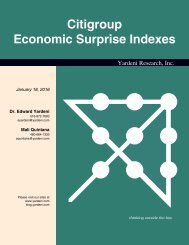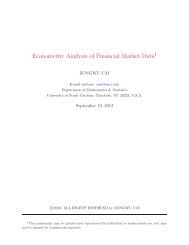Illiquid Asset Investing 1. Liquidating Harvard
Illiquid Asset Investing 1. Liquidating Harvard
Illiquid Asset Investing 1. Liquidating Harvard
You also want an ePaper? Increase the reach of your titles
YUMPU automatically turns print PDFs into web optimized ePapers that Google loves.
Andrew Ang <strong>Illiquid</strong> <strong>Asset</strong> <strong>Investing</strong> <strong>Asset</strong> Management<br />
cyclical, it supplies liquidity. Dynamic portfolio rules, especially those anchored by simple<br />
valuation rules (see Chapters XX and XX) extend this further – as long as they buy when others<br />
want to sell and vice versa. It is especially important to rebalance illiquid asset holdings too,<br />
when given the chance (see also below).<br />
Purists will argue that rebalancing is not strictly liquidity provision; rebalancing is an asset<br />
management strategy. Rebalancing, in fact, requires liquid markets to implement. But prices<br />
exhibit large declines often because of blowouts in asymmetric information, or because funding<br />
costs rapidly increase so that many investors are forced to offload securities – some of the key<br />
reasons giving rise to illiquidity listed at the start of Section 2. Brunnermeier (2009) argues that<br />
these effects played key roles in the meltdown during the financial crisis. In the opposite case,<br />
rebalancing makes available risky assets to new investors, potentially with lower risk aversions<br />
than existing clientele or those who chase past high returns, or to investors who load up on risky<br />
assets when prices are high because they have abundant access to leverage and they perceive<br />
asymmetric information is low. In this general framework, rebalancing provides liquidity.<br />
Large asset owners give up illiquidity premiums by sheepishly tracking standard indexes. When<br />
indexes change their constituents, asset owners demand liquidity as they are forced to follow<br />
these changes. Index inclusion and exclusion induce price effects of 3-5%, and these effects have<br />
become stronger in more recent data. 37 Large asset owners should be collecting index<br />
reconstitution premiums instead of paying them. They can do this by using their own proprietary<br />
benchmarks. Candidate indexes could emphasize illiquidity security characteristics, but more<br />
generally would be built around harvesting factor risk premiums (see Chapter XX). Even an<br />
37<br />
See Chapter XX and the literature on index reconstitution effects summarized by Ang, Goetzmann and Schaeffer<br />
(2011).<br />
30




